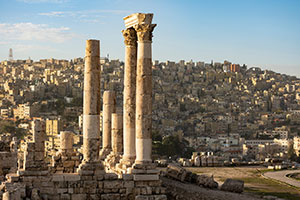|
Duba
|
|
|
Feynan
|
|
Petra
Petra
From Jordan's port on the Red Sea, you can travel to the mysterious lost city of Petra, which was hidden for centuries. At first it looks like a mirage: rugged sandstone hills seem to melt into windows and doorways, columns and gargoyles. But it is not: all the buildings of Petra, except one, were elaborately carved into the rock hills by a nomadic Arabian tribe in the 6th century B.C. It is a remarkable sight. You can also visit Wadi Rum, where Bedouin families set black goat-hair tents at the base of massive, striated "jebels," the sheer-faced hills of the region.
|
Destination Guide
|
Wadi Rum
Wadi Rum
Wadi Rum or Valley of the Moon, is a valley of sandstone and granite rock situated in southern Jordan. Wadi Rum has been inhabited by nomads since prehistoric times and is currently home to the Zalabia Bedouin people who guide ventures of climbers and trekkers. Eco-adventure tourism is a developing success and their main source of income. Travelers can visit the key spots of Wadi Rum’s desert history: the Thamudic inscriptions of Wadi Rum, Nabatean Temple, and Seven Pillars of Wisdom.
|
Destination Guide
|
Dead Sea, Jordan
Dead Sea, Jordan
Straddling the border between Israel and Jordan, the Dead Sea is the lowest spot on the Earth's surface. If you head there from Amman, don't nod off: The view as you descend from the hills toward the sea is quite striking. The mineral content of this 45-mi-/75-km-long and 6-mi-/10-km-wide saltwater lake tops out at 33%. The Dead Sea should be seen (and stepped into) at least once in every person's life—it's impossible to sink—but some mild words of caution are in order: Don't shave shortly before swimming (the high salt content will leave you with an excruciatingly painful experience), and take some eyedrops along (getting even a tiny drop of the thick water in your eye is painful). Also try to make sure there are shower facilities or a freshwater stream in which to rinse off nearby—otherwise, the sea's minerals will leave an uncomfortable crust on your skin. Near the northern end of the Dead Sea are several spa and beach resorts, including the lovely Movenpick Resort and the luxurious Kempinski Hotel Ishatar, which was inspired by the Hanging Gardens of Babylon. Visitors who are not guests of the resort can generally take advantage of the health and beauty treatments at the spas if they purchase a day membership. For centuries, people have traveled to the Dead Sea to enjoy its beauty as well as its healing properties. Many people go there for relief from chronic ailments such as dermatological problems, asthma, arthritis, circulatory issues and hypertension. The composition of the Dead Sea contains contains high levels of magnesium, calcium, sodium and potassium, making it rich in life-enhancing minerals. A bit inland from the sea, in a beautiful oasis, are thermal springs (including a waterfall) at Hammamat Ma'in. Also nearby is Bethany Beyond the Jordan, which archaeologists believe to be the site where John the Baptist lived and preached, and where he baptized Jesus. The ruins of a Byzantine church were built on what early Christians identified as the spot where Jesus left his robes. Elsewhere, you can visit the Baptist's Spring, which may have been John's cave where he sheltered, and several other churches and baptism pools. Nearby is Jebal Mar Elias, a small hill referred to in the Bible as Hermon, where the prophet Elijah ascended to heaven in a chariot of fire. About midway along the sea's shore is the Mujib Reserve. This protected area encompassing a gorge, mountains and valleys boasts an impressive biodiversity of both plants and wildlife. It also has two marked hiking trails and a campsite. At the southern end of the sea, not far south of Wadi Mujib, is the site identified as Lot's Cave, where the biblical figure was said to have taken refuge after escaping from the destruction of Sodom and Gomorrah. A Byzantine church built over the cave entrance has been excavated and is open to the public. A shell-shaped museum has been built 984 ft/300 m from the entrance to Lot's Cave. North of Lot's Cave are the sites of what are believed to be the cities of Sodom and Gomorrah, which show signs that they were indeed destroyed by fire. Try to see the sunset at the Dead Sea at least once—it's worth it. The Dead Sea is 25 mi/40 km southwest of Amman.
|
Destination Guide
|
Amman
Amman
Amman has served as the modern and ancient capital of Jordan. It is one of the oldest continuously inhabited cities in the world and is built on seven enchanting hills. Gleaming white houses, kebab stalls and cafes are interspersed with bustling markets and the remains of civilizations and ages long past. The greatest charm of Amman, however, is found in the hospitality of its residents who give visitors a warm welcome.
|
Destination Guide
|
Luxor
Luxor
Aside from visiting the pyramids near Cairo, Luxor and Al Karnak are places not to be missed when in search of ancient Egyptian monuments and artifacts. Luxor is on the southern part of ancient Thebes, Al Karnak on the north. Between the two, visitors can lose themselves for days in the hundreds of temples, chapels, tombs and gardens in the area. Too extensive to list all of them, a few of the tombs not to be missed are the tombs of Nefertari, Amenhotep II & III, several Ramesses and Tutankhamen.
|
Destination Guide
|
Aswan
Aswan
Aswan is Egypt's sunniest southern city and has a distinctively African atmosphere. The pace of life here in the most beautiful setting on the Nile is slow and relaxing. It is a favorite winter resort spot for Europeans, Middle Easterns and Africans alike - it's a perfect place to get away from it all. Strolling up and down the Corniche, one can watch sailboats glide by. Savor the flavor of locally caught fish while listening to Nubian music or wander in the bazaar and get lost in the sights and sounds of this mystical place. Visit the Aga Khan Mausoleum, the Monastery at Qubbat al-Hawa, the Unfinished Obelisk, The Tombs of the Nobles, Qubbat al-Hawa, the Monastery at Aswan , or the St. Simeon monastery (Anba Hatre), uninhabited and just outside of Aswan.
|
Destination Guide
|
Cairo (Alexandria)
Cairo (Alexandria)
This Mediterranean city, blessed with a mild, pleasant climate and white beaches, is a popular playground and the country's summer capital. Nightclubs, sidewalk cafes and restaurants lining the Corniche add to Alexandria's attractions. There are museums, Roman theater, and catacombs to explore. Alexandria also serves as gateway for excursions to Cairo and the famous El Alamein battlefield. Visitors will find plenty of interest in this "Pearl of the Mediterranean." Good shopping buys include gold and silver jewelry, especially the gold cartouche with your name inscribed in hieroglyphs, cotton goods, carpets, leather articles, copper- and brassware, basketware and papyrus prints. The city boasts a reputation of having the country's best food. Other sights include: Ras at-Tin Palace, with its surrounding gardens; Hussein Sobhy Museum of Fine Arts; and Hotel Cecil, a grand and elegant hotel with romantic and intriguing history. There is a War Museum and Commonwealth War Cemetery.
|
Destination Guide
|
Cairo
Cairo
Cairo and the ancient monuments of the Egyptian empire have fascinated visitors throughout the centuries. The mystifying Sphinx and the pyramids of Giza, over four thousand years old, stand majestically on the outskirts of the city at the edge of the desert. Cairo's Museum of Antiquities holds one of the finest collections of artifacts in the world, including the astounding treasures of King Tutankhamen's tomb.
|
Destination Guide
|
Bahir Dar
Bahir Dar
With its welcoming palm tree lined avenues, Bahir Dar (Bahar Dar) is one of the leading tourist destinations in Ethiopia and it offers a variety of attractions to enjoy. Blue Nile River and Blue Nile Falls is one of the most popular attractions, with the rainy season being the most dramatic time to view the falls. Nearby to Bahir Dar is Lake Tana which has 37 islands, and 20 monasteries. These island churches can be accessed by boat in about 30 minutes, and offer a unique opportunity for visitors to see inside the Ethiopian Coptic Churches to enjoy the art and unique architecture of the monasteries. Visitors won’t want to miss the Bahir Dar market, an open-air market where locals sell unique, handmade items and foods.
|
|
Simien National Park
Simien National Park
A trek 325 mi/525 km northwest of Addis Ababa in the Simien Mountains is likely to be the high point of a visitor's time in Ethiopia. (The highest peaks top 13,100 ft/4,000 m.) The breathtaking mountain landscape and vegetation provide some of the finest scenery in the country. Many of the animals living in the Simien Mountains exist only in Ethiopia and some exist only in the Simiens. Lammergeyer vultures, whose wingspan reaches up to 10 ft/3 m, are protected by national park rules. Endemic mammals include the Ethiopian wolf (an endangered species), Gelada monkeys (which live in large, grass-eating troops that display little fear of humans) and the goatlike Walia ibex. The Simiens are also home to several endemic plants, including a form of giant lobelia whose hollow seedpod can grow up to 20 ft/6 m high and was often used by soldiers for stashing arms. The park's headquarters are at Debark, on the main road. Park authorities will provide a guide and an armed scout (in case of poachers) and will arrange for the rental of mules to carry additional food and gear. The guide, scout, trekking permit and mules should cost about US$200 for a week. Visitors can buy supplies and rent camping stoves in Debark, but tents and warm sleeping bags should be carried from home. Take warm clothing as well as protection from the sun and rain. (The rainy season is May-October.) Although only limited food is available in the small towns within the park, the Muslim villagers (who have lived in this mostly Christian region since the 17th century) are happy to supply nonalcoholic barley beer to thirsty hikers.
|
Destination Guide
|
Gondar
Gondar
Founded by Emperor Fasilidas in the 17th century in the shadow of the Simien Mountains 260 mi/420 km northwest of Addis Ababa, Gonder certainly merits a visit. Once the Ethiopian capital, the town has distinctive castles and cathedrals, incorporating medieval European and southern-Arabian influences. Be sure to see the abbeys, the Castle of the King Fasilidas, the Monastery of Kusquam, the House of Kusquam (Queen Mintiwab's palace) and other ruins. Gonder has dozens of churches, the most important being Debre Birhan Selassie (Trinity of the Mountain of Light), which has an impressive hilltop location. The priest there will explain the story of the many paintings and carvings inside the church. Nearby is a former Falasha (Ethiopian Jew) community. Although all of the Falasha were airlifted to Israel years ago, you can still tour the synagogue and buy some traditional Falasha pottery (made by current residents).
|
Destination Guide
|
Lalibela
Lalibela
Missing this town would be like going to Egypt and not seeing a pyramid. Lalibela's 11 Orthodox churches are some of the world's greatest architectural marvels, and the town has been designated a UNESCO World Heritage Site. Each church was carved out of a solid piece of red volcanic rock in the 1100s. The largest, Medhane Alem, measures an incredible 100 ft/30 m long, 77 ft/24 m wide and 37 ft /11 m high. Beta Giorgis (the Church of St. George) is shaped like a cross and surrounded by a 40-ft-/12-m-deep trench. Historians say that the churches were commissioned by King Lalibela, who claimed to have been instructed by God in a dream to build the most beautiful places of worship on Earth. Legend says that the churches were completed in 24 years with the help of angels. The churches have beautifully painted facades, tunnels and a cloth (in the Pillar of Light Church) upon which Christ was said to have leaned when appearing to King Lalibela in a dream. The churches are accessible through carved ravines and eerie subterranean passageways lined with grottoes containing the bones of past clergy. Built as the king's own "New Jerusalem" 210 mi/340 km north of Addis Ababa, Lalibela strikes many visitors as one of the most sacred, strangely mystical places on Earth, particularly during religious festivals, when pilgrims arrive from around the country. Bet Maryam (the Church of St. Mary), is especially festive on Christmas Eve. Most of the churches still hold weekly services. Our favorite nonreligious experience in Lalibela is the Saturday market, a good place to see Ethiopian villagers trading goats, cows, cloth and vegetables. Outside Lalibela, a local charity called TESFA works with local communities to offer simple facilities catering to tourists who wish to get off the beaten trail, trek in breathtaking scenery and see the real culture of the highlanders. Centered on Meket Woreda, the local communities manage the enterprises and retain the proceeds from it.
|
Destination Guide
|
Axum
Axum
This holy city and former capital, found 350 mi/565 km north of Addis Ababa in the northern province of Tigrai, is ancient, dating back 2,000 years. A major stop in caravan routes heading to the Red Sea, Aksum (the early site is referred to as Axum) was the home of Ezana, the Ethiopian king who converted to Christianity in the fourth century. Several sites in Aksum are legendarily associated with the Queen of Sheba, to whom Ethiopians refer as Makeda and claim was impregnated by King Solomon on a visit to Jerusalem. The fruit of this royal union was Emperor Menelik I, the founder of the so-called Solomonic Dynasty that ruled Ethiopia almost continuously until the death of Haile Selassie almost 3,000 years later. However, most credible historians regard these legends as pure fabrication, and sites such as the "Queen of Sheba's Palace" and the "Queen's Well," although very ancient, probably postdate her era by several centuries. An equally unverifiable local legend has it that the Ark of the Covenant was stolen from King Solomon by his son Menelik I and now lies in a special building in the fourth-century church compound of Tsion Maryam (Mary of Zion). The chapel is guarded night and day by a monk who is forbidden to let anyone inside. What is true is that sometime after the conversion to Christianity, Ezana's dynasty incorporated the Solomon story into its origins. Not to be outdone, later dynasties, such as that associated with King Lalibela, went to even greater historical depths and claimed Moses as their founder. A display in a modern church in Aksum contains the crowns of ancient kings. Although the civil war left its scars, most of Aksum's ruins, which date from AD 400, were untouched. The ruins include palaces, buildings and dozens of stelae, or obelisks, each carved from a single piece of stone (some as tall as 75 ft/22 m). The stelae, several of which have fallen, mark the burial places of Aksumite kings and resemble three- or four-story buildings, complete with windows and doors.
|
Destination Guide
|
Addis Ababa
Addis Ababa
Addis Ababa is the capital of Ethiopia. It houses the African Union and the United Nations Economic Commissions of Africa, in result it is often referred to as the capital of Africa. The city’s diversity is clearly apparent when noticing the many churches, mosques, and museums. The main attraction is located in the Ethiopian National Museum where you can find the fossilized skeleton of Lucy, the Australopithecine discovered in the 1970s.
|
Destination Guide
|






